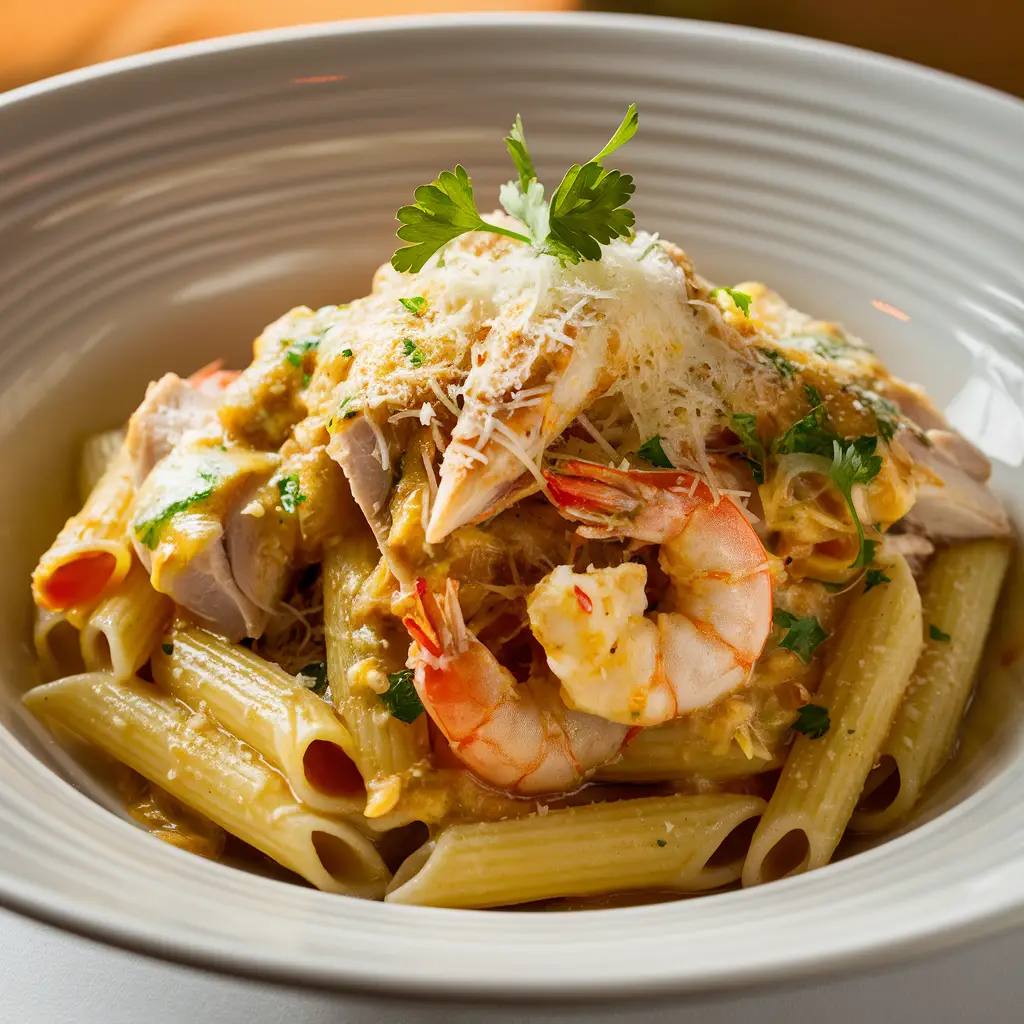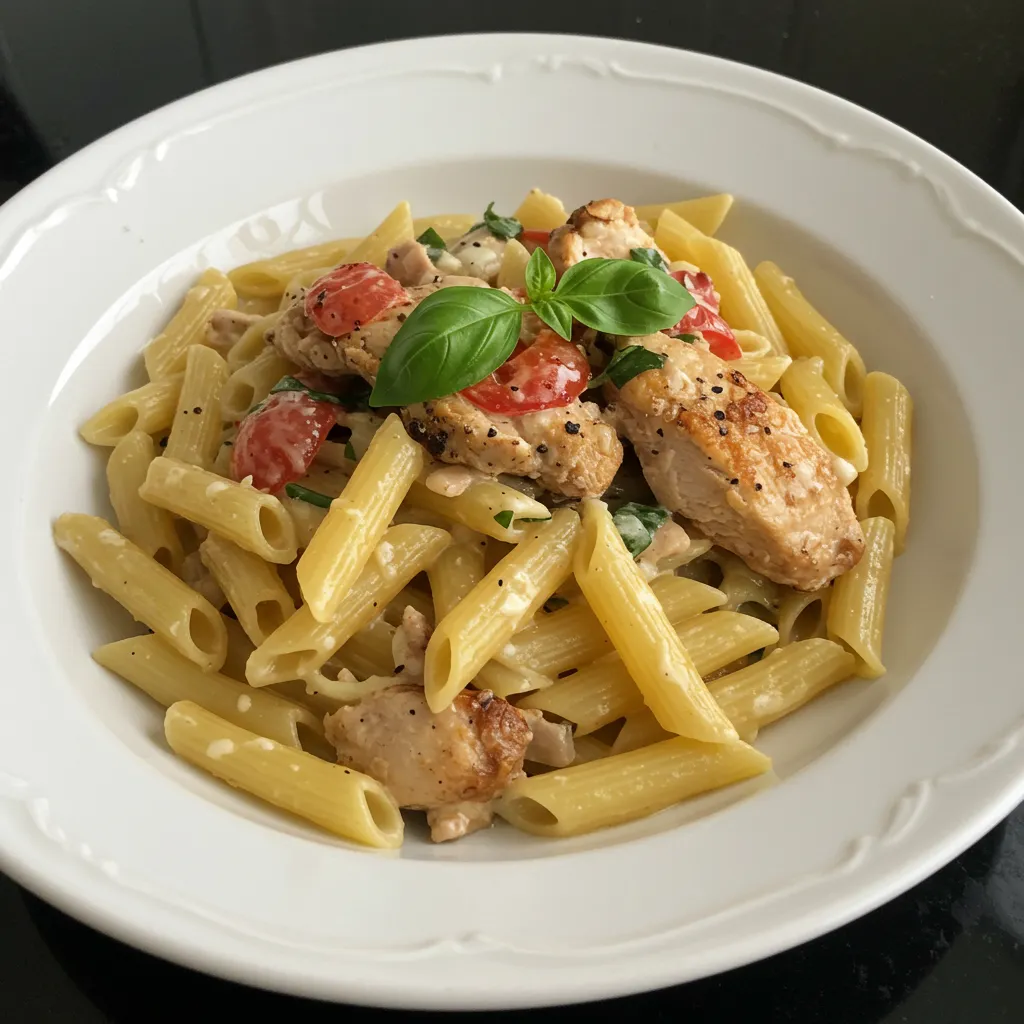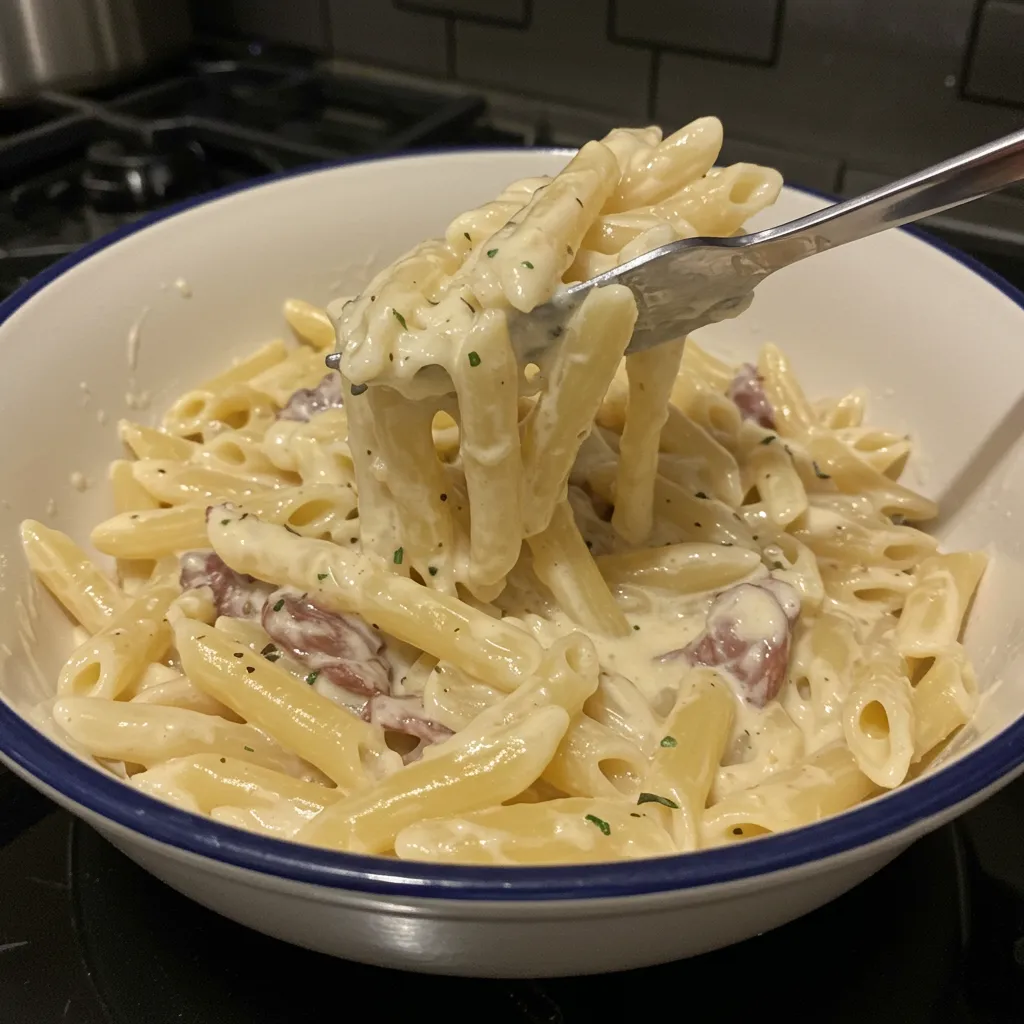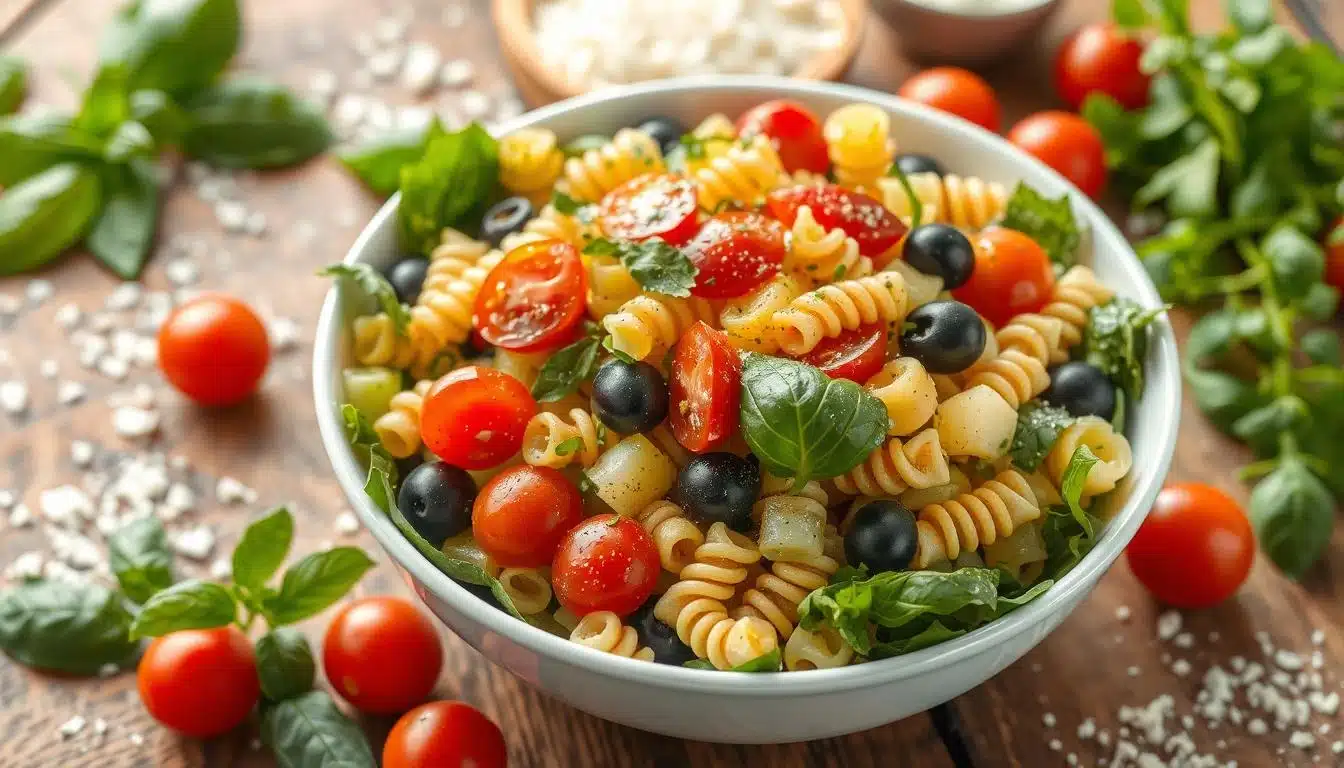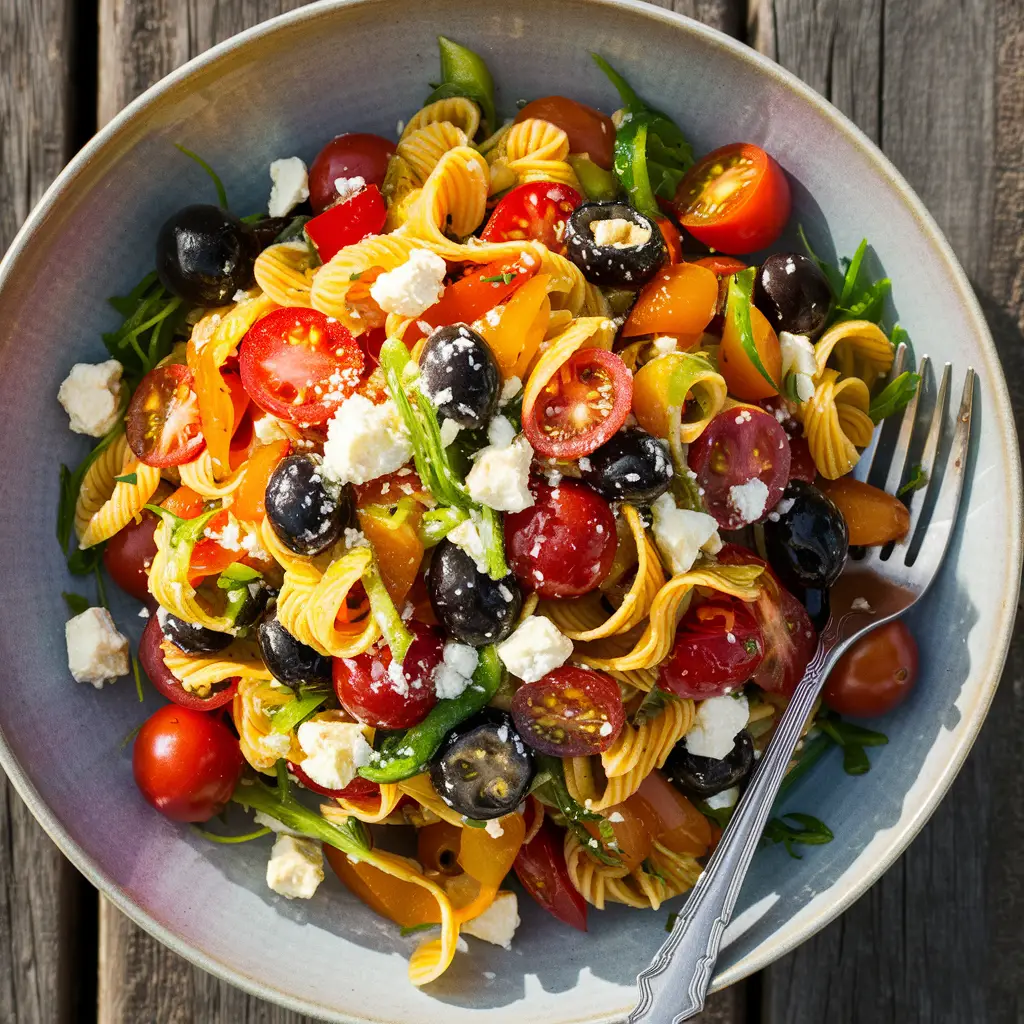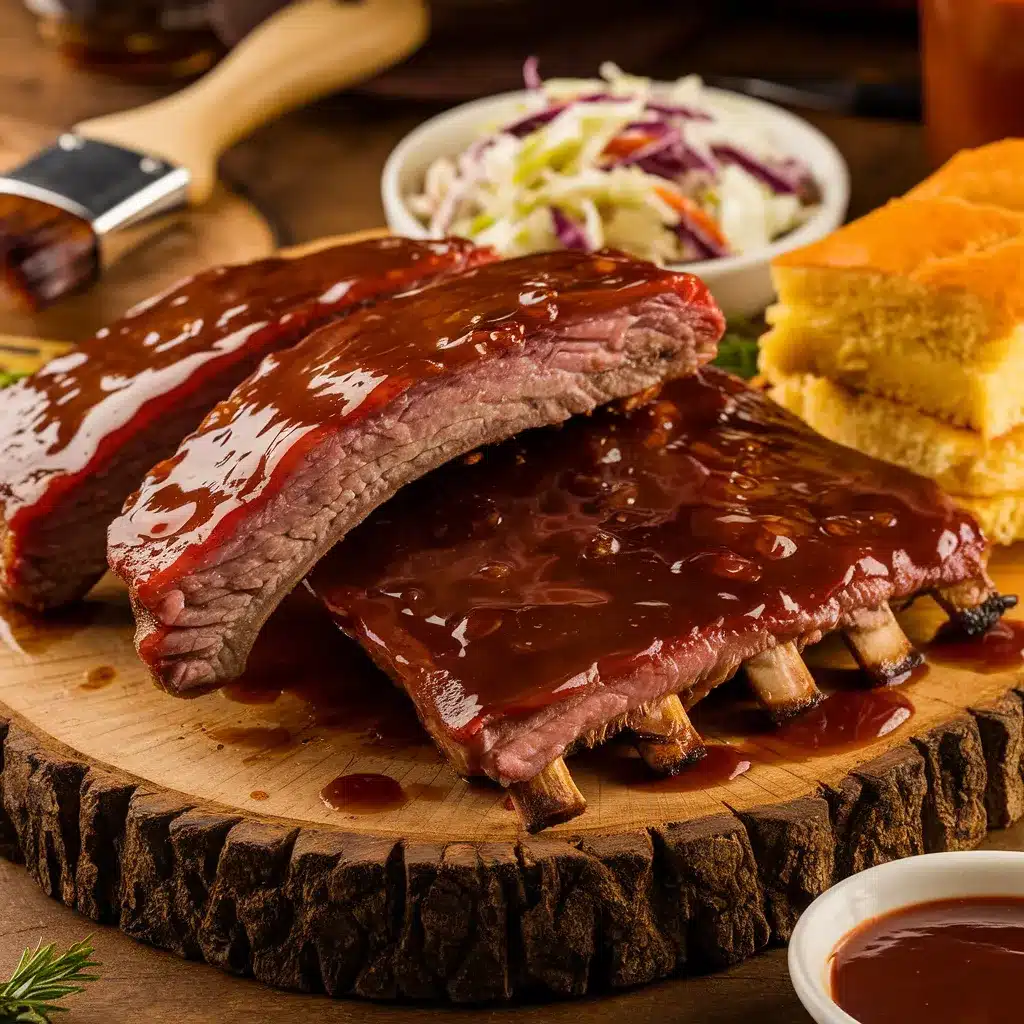Indulgent Lobster Pasta Recipe: A Gourmet Delight for Any Occasion
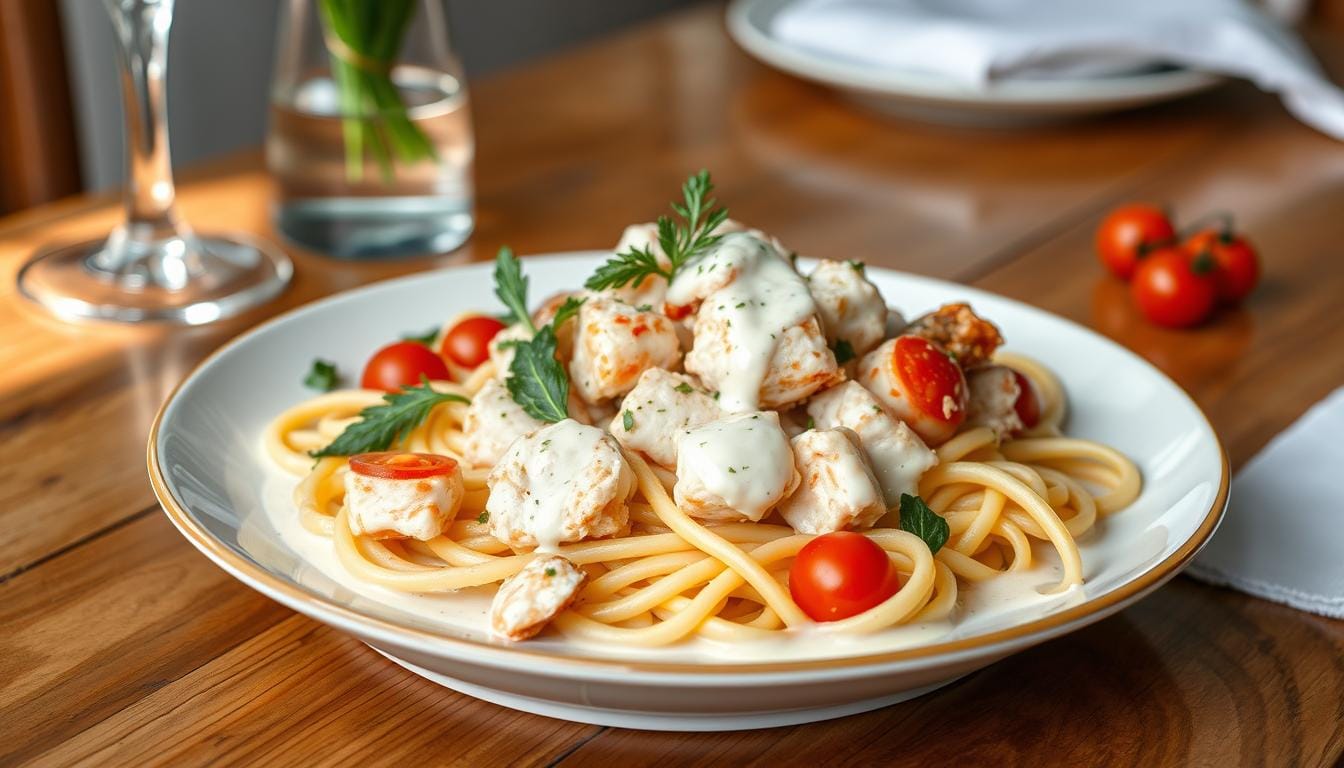
As the sun sets, the evening chill brings a cozy feeling. Nothing beats a warm plate of pasta. Tonight, we’re making a luxurious lobster pasta in just 30 minutes. It’s a flavor journey to the Italian coast, right in your kitchen.
Picture tender lobster meat in a creamy tomato sauce, all over perfectly cooked pasta. This recipe shows how simple ingredients can make a special dish. It’s perfect for any occasion, whether you’re hosting or treating yourself.
Table of Contents
Why Lobster Pasta is the Perfect Quick Luxury Meal
Experience the taste of Italy’s coastal cuisine with lobster linguine. This dish is a mix of rich seafood and Italy’s cooking traditions. The lobster’s sweetness pairs well with the pasta’s firmness, making it a treat for your taste buds.
The History of Italian Coastal Cuisine
Lobster pasta comes from Italy’s seaside towns. For years, fishermen and women have caught seafood, including lobster. This tradition has made lobster a key ingredient in gourmet cooking.
Benefits of Quick Gourmet Cooking
- Impressive Meals in Minimal Time: Enjoy a fancy dish at home with less prep time.
- Versatility for Any Occasion: It’s great for any meal, from weeknights to celebrations.
- Appealing to a Wide Audience: It’s loved by both seafood fans and pasta lovers.
Try this lobster pasta recipe for a quick, indulgent meal. It’s perfect for any day of the week.
Essential Ingredients for Restaurant-Quality Lobster Pasta
To make a delicious lobster pasta dish like a fancy restaurant, start with the best ingredients. You’ll need lobster pasta ingredients like fresh lobster and high-quality pasta like spaghetti or linguine.
You’ll also need some important ingredients to add flavor. These include tomato paste, passata, extra virgin olive oil, garlic, and a small yellow onion. Heavy cream, fresh basil, chives, and optional red pepper flakes are also needed. For four servings, use 4 lobsters (about 1.5 lbs each), 1 lb of pasta, 4 tablespoons of butter, and 2-3 tablespoons of olive oil. You’ll also need 1 large shallot, 2 teaspoons of red pepper flakes, 1.5 cups of dry white wine, and 2 cups of heavy cream.
“The key to an exceptional lobster pasta dish is using the freshest, highest-quality ingredients you can find. It’s all about letting the natural flavors of the lobster and pasta shine through.”
With these ingredients, you’re ready to make a lobster pasta dish that’s restaurant-quality. Let’s move on to the next steps to make your dish a hit.
Selecting and Preparing Fresh Lobster
Creating a delicious lobster pasta dish starts with fresh, high-quality lobster. Whether you choose live lobsters or pre-cooked tails, focus on the selection process. This will make your meal a hit.
How to Choose the Best Lobster
For the best taste and texture, look for these traits:
- Live lobsters should be active and lively, with tails that curl tightly when gently pulled.
- Lobster tails should be firm to the touch and free of any discoloration or damage.
- Avoid pre-cooked lobster tails that appear dry or shriveled, as these may have lost their natural sweetness and texture.
- When purchasing live lobsters, choose ones that weigh approximately 1.25 pounds for the ideal balance of meat and flavor.
Proper Cooking Techniques
After picking your lobster, it’s time to cook it. Here’s how to cook it right:
- Bring a large pot of salted water to a rolling boil.
- Carefully lower the live lobster into the boiling water and cook for 8-9 minutes, or until the shell turns a vibrant red color.
- Remove the lobster from the water and let it cool completely before handling.
- Using kitchen shears, cut along the underside of the lobster to extract the sweet, tender meat.
- Chop the lobster meat into bite-sized pieces, being cautious to remove any remaining shell fragments.
- Reserve the lobster shells to create a flavorful stock for your pasta sauce.
By following these steps, your lobster will be cooked perfectly. This will add a delightful texture and flavor to your homemade lobster pasta.
The Perfect Pasta Selection Guide
Choosing the right pasta is key to a great lobster pasta dish. Opt for bronze-extruded pasta for better sauce adhesion. Spaghetti or linguine are classic picks that pair well with lobster.
To cook pasta to al dente, use a large pot of salted, boiling water. Follow the package guide but cook for a minute less. This keeps the pasta firm and tasty. Different shapes cook at different times – spaghetti takes 8-10 minutes, while thicker shapes like penne or rigatoni need 12-15 minutes. Always taste the pasta to check if it’s just right.
By picking the right pasta types for lobster and mastering the al dente pasta method, you’ll make a dish that wows everyone. Remember, the secret to perfection is in the details. Don’t hesitate to try different pasta shapes and cooking methods to find what you like best.
Creating the Ultimate Creamy Lobster Sauce
Making a rich creamy lobster sauce is key to making your lobster pasta dish amazing. This sauce perfectly complements the tender lobster meat, creating a perfect balance of flavors. Let’s dive into the steps to master this culinary delight.
Base Ingredients for the Sauce
Start by sautéing onions and garlic in a lot of salted butter. This creates the base flavor of the sauce. Then, add a bit of tomato paste for a rich, slightly acidic taste. Finish by deglazing the pan with white wine, blending the flavors together.
The sauce’s heart is the cooked lobster meat. Mix in the tender lobster and lobster stock for a rich base. To get a smooth texture, add heavy cream. Whisk it in well and let the sauce simmer to meld the flavors.
Seasoning Tips and Tricks
Seasoning is key for the ultimate lobster pasta sauce. Start with salt and pepper to taste, aiming for a balanced flavor. For a bit of heat, add red pepper flakes. A sprinkle of Parmesan cheese adds a savory, nutty taste.
The secret to perfection is tasting and adjusting as you go. The creamy lobster sauce should highlight the lobster. By following these steps, you’ll make a creamy lobster pasta dish that will wow your guests.
Step-by-Step Lobster Pasta Recipe
Get ready to enjoy a delicious lobster pasta dish at home. This lobster pasta recipe is quick to make, just 30 minutes. It’s a meal that tastes like it came from a fancy restaurant. Follow this step-by-step guide to make a luxurious lobster pasta that will wow your guests.
- First, boil a large pot of salted water. Cook 10 ounces of linguine pasta for 1-2 minutes. It should be al dente.
- In a big skillet, melt 3 tablespoons of unsalted butter over medium heat. Add 1 finely chopped shallot and 3 minced garlic cloves. Cook for 2 minutes until they’re fragrant and lightly golden.
- Then, stir in 2 tablespoons of tomato paste. Use a splash of white wine to deglaze the pan and get all the browned bits.
- Next, pour in 1 cup of lobster stock. Let the sauce simmer for 2-3 minutes to thicken a bit.
- Now, gently fold in 12 ounces of cooked and chopped lobster meat, and 1 cup of heavy cream. Season with 2 teaspoons of dried Italian seasoning.
- Drain the cooked linguine, keeping 1/2 cup of the pasta water. Add the pasta to the lobster sauce, tossing to coat. If it’s too thick, add a bit of the pasta water.
- Finally, remove from heat and stir in 1/2 cup of grated Parmesan cheese. Top the lobster pasta with fresh basil leaves before serving.
This lobster pasta recipe makes 4 servings and is ready in about 30 minutes. It’s a dish that looks and tastes like it was made by a pro chef, all from your kitchen.
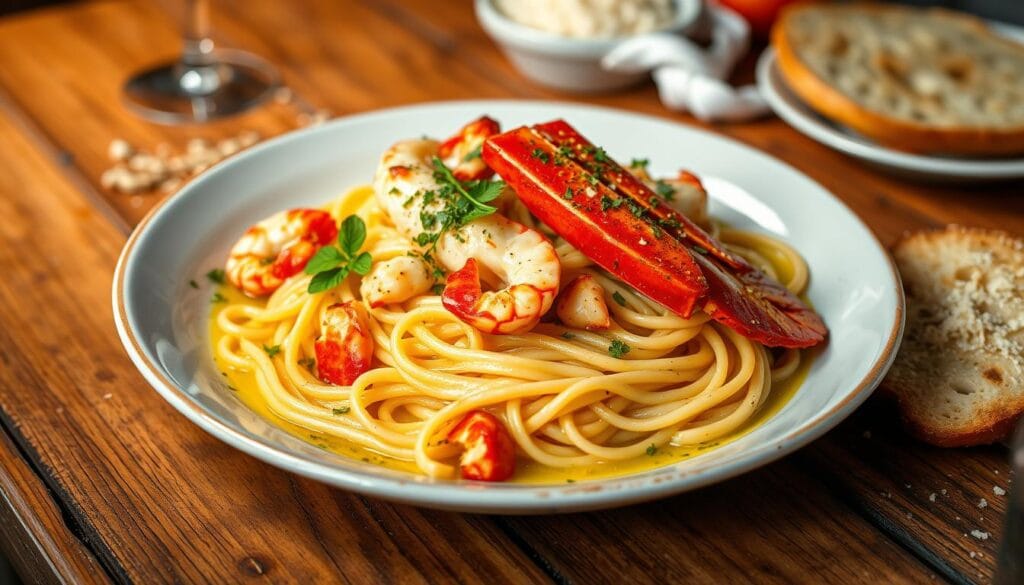
Secret Tips for Al Dente Pasta Excellence
Getting the perfect al dente pasta texture is key to great Italian food. Follow these secret tips to make restaurant-quality pasta at home.
Timing Your Pasta Perfectly
Timing is everything for al dente pasta. Start with the package instructions, but test the pasta 1-2 minutes early. It should still have a bit of chew when you bite it.
Water-to-Pasta Ratio Guidelines
Use a big pot and lots of water for even cooking. Aim for 4-6 quarts of water per pound of pasta. This helps the pasta cook without sticking together. Stir it now and then to cook evenly.
| Pasta Type | Recommended Water Quantity |
|---|---|
| Spaghetti | 4-6 quarts |
| Penne | 4-6 quarts |
| Linguine | 4-6 quarts |
| Fusilli | 4-6 quarts |
| Rigatoni | 4-6 quarts |
Save a cup of pasta water before draining. This water can help your sauce stick to the pasta better.
Mastering the Sauce-to-Pasta Combination
Getting the perfect mix of creamy lobster sauce and pasta is crucial for a delicious dish. The secret is in how you mix these two. With a few simple steps, you can make sure every bite is full of flavor and just right.
Begin by moving the cooked pasta from the pot to the saucepan with tongs or a slotted spoon. This brings some starchy pasta water along, which helps the sauce blend better. Then, gently toss the pasta and sauce together. This lets the starch thicken the sauce naturally. If the sauce gets too thick, add a little pasta water to thin it out.
- Ensure even coating of the sauce on the pasta.
- Distribute the lobster meat evenly throughout the dish.
- Adjust the sauce-to-pasta ratio as needed to achieve the desired creaminess and texture.
Mastering how to mix pasta and sauce will take your lobster pasta dish to new heights. You’ll get a perfect blend of flavors and textures that will amaze your guests.
“The secret to a great pasta dish is in the perfect balance of the sauce and the pasta. It’s all about finding that sweet spot where they complement each other perfectly.”
Success comes from the details. Paying close attention to the sauce-to-pasta ratio and how you mix them will help you create an amazing lobster pasta dish. It will impress even the most picky eaters.
Fresh Herbs and Aromatics That Enhance Flavor
Make your lobster pasta dish special by adding fresh herbs and aromatics. These ingredients can turn a simple meal into a gourmet treat. Choose classic herbs like basil, parsley, and tarragon. Chop or chiffonade them just before adding to keep their flavors and scents bright.
Best Herb Combinations
- Basil and parsley: A timeless duo that brightens up the dish with their earthy, slightly peppery notes.
- Tarragon and chives: The anise-like flavor of tarragon paired with the subtle onion notes of chives creates a sophisticated blend.
- Rosemary and thyme: These woodsy herbs lend a rustic, Mediterranean flair to the lobster pasta.
Garlic and Shallot Preparation
For the aromatic base, thinly slice fresh garlic and finely dice shallots. Sauté them gently in olive oil or butter to release their flavors. This method helps to caramelize the natural sugars, adding depth and complexity to the dish. A sprinkle of red pepper flakes can also add a subtle kick, balancing the lobster’s sweetness.
Don’t forget to season with salt and freshly cracked black pepper to taste. These simple additions of fresh herbs and aromatics will take your lobster pasta to new flavor heights.
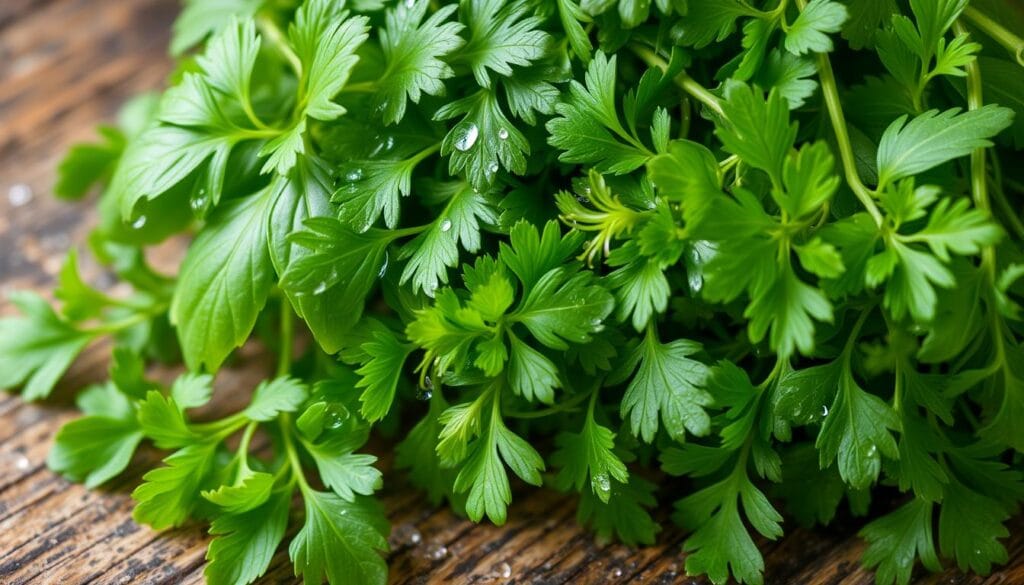
Wine and Ingredient Pairings for Lobster Pasta
To make your lobster pasta taste like it’s from a fancy restaurant, choose the right wine and ingredients. Lobster’s sweetness goes well with crisp, acidic white wines. These wines balance the dish’s creaminess.
For the best wine, try a chilled Chardonnay or Sauvignon Blanc. They have fruity flavors and a refreshing acidity. This acidity cuts through the lobster and cream sauce’s richness. If you like something lighter, Pinot Grigio or Vermentino are great choices too.
Cherry tomatoes add a sweet burst. Arugula or spinach add a peppery contrast. For a savory touch, add crispy pancetta or prosciutto.
A simple green salad with a tangy vinaigrette cleanses your palate. And don’t miss the warm, crusty garlic bread. It’s perfect for soaking up the creamy lobster sauce.
| Wine Pairing | Complementary Ingredients |
|---|---|
| Chardonnay | Cherry tomatoes, pancetta, arugula |
| Sauvignon Blanc | Spinach, prosciutto, lemon zest |
| Pinot Grigio | Roasted garlic, basil, grilled shallots |
| Vermentino | Roasted red peppers, capers, parsley |
Plating Techniques for Instagram-Worthy Presentation
Turning your lobster pasta dish into a masterpiece is not just about taste. It’s also about how it looks. Learning to plate your pasta can make a tasty meal into a stunning work of art. It’s perfect for sharing on Instagram.
Garnishing Tips
Start by serving your lobster pasta in warm, shallow bowls. This lets you see the creamy sauce and tender lobster. Use a fork and spoon to twirl the pasta for a fancy look.
Add fresh herbs like chives or parsley to brighten up the dish. Drizzle olive oil around the bowl’s edges for a beautiful contrast.
Color and Texture Balance
- For texture, try adding toasted breadcrumbs or pine nuts on top.
- Make sure the lobster is spread out evenly in the pasta. This makes the dish look balanced and appealing.
- Play with colors like green herbs against the creamy sauce. This makes your lobster pasta pop.
By focusing on plating details, you can make your homemade lobster pasta look like it came from a restaurant. These easy tips will impress your friends and family with your pasta plating techniques and food presentation skills.
Storage and Reheating Guidelines
Storing your lobster pasta leftovers is simple. Just put the pasta in an airtight container and chill it in the fridge for up to 3 days. When you’re ready to eat it again, a quick warm-up on the stovetop brings back the creamy sauce and seafood flavors.
To reheat, add a bit of water or cream to the container. Then, warm it over medium-low heat, stirring now and then. This method keeps the lobster tender and the pasta just right. Don’t use the microwave, as it can make the seafood tough.
For the best taste, eat your storing lobster pasta within 1-2 days after refrigerating. This keeps the dish’s flavor and texture at their best. With these easy tips, you can enjoy your reheating seafood pasta whenever you want.
| Storage Method | Maximum Storage Time | Reheating Recommendation |
|---|---|---|
| Refrigerator | 3 days | Stovetop with added water or cream |
| Freezer | 6 months | Thaw in refrigerator, then reheat on stovetop |
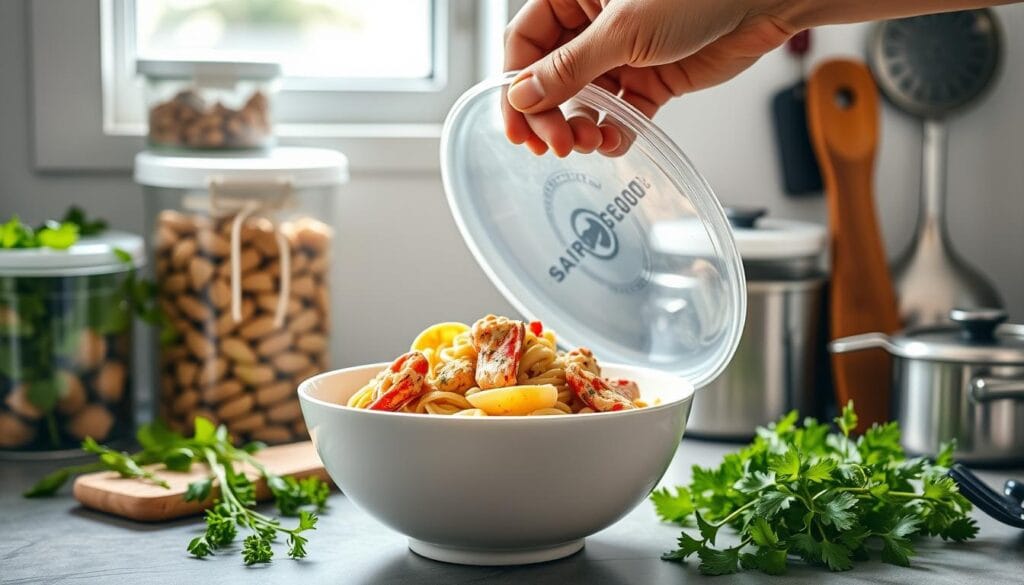
“Proper storage and reheating techniques are key to enjoying the full flavor and texture of this delectable lobster pasta dish.”
Common Mistakes to Avoid When Making Lobster Pasta
Making lobster pasta can be a fun cooking journey. But, it’s key to avoid some common mistakes to make it truly great. Overcooking seafood and pasta, and getting the sauce-to-noodle ratio wrong are big no-nos. These errors can mess up the taste and texture of your dish.
One big mistake is overcooking the lobster. It can get tough and rubbery if cooked too long. To get it just right, watch the lobster closely while it cooks in the sauce. Also, don’t overcook the pasta. It should be al dente for the best taste and texture.
Another mistake is rinsing pasta after cooking. It might seem like a way to stop it from sticking, but it removes the starches. These starches help the sauce stick to the pasta. Instead, toss the hot pasta into the sauce to create a better mix.
When adding lobster meat to the sauce, handle it gently. You want the flavors to mix well without breaking the lobster. Also, use the best ingredients, especially in the sauce. Low-quality ingredients can ruin the dish’s taste and quality.
By avoiding these mistakes, you can make a lobster pasta dish that will wow everyone. Paying attention to detail and using the freshest ingredients will take this classic dish to new heights.
“The key to a truly exceptional lobster pasta dish is not just in the ingredients, but in the attention to detail throughout the entire cooking process.”
Variations on the Classic Lobster Pasta Recipe
Why not try some new twists on the classic lobster pasta? You can add spice or try different sauces. There’s a whole world of flavors to discover.
Spicy Alternatives
For a spicy kick, add red pepper flakes or cayenne pepper to the sauce. This adds a nice heat that goes well with the lobster’s sweetness. Or, make a lobster fra diavolo for a bolder, spicier dish.
Different Sauce Options
Try new sauce bases to make your lobster pasta even better. A creamy lobster carbonara with egg yolks and Parmesan is rich and luxurious. Or, go for a lobster Alfredo with butter, heavy cream, and Parmesan for a velvety sauce.
For something lighter, use a lemon-infused olive oil sauce. The lemon’s acidity and the olive oil’s fruity taste offer a refreshing contrast to the lobster’s richness.
Want to try something different? Mix in shrimp or scallops for a seafood pasta dish. The mix of textures and flavors makes for an unforgettable meal.
“Variety is the spice of life, and that’s certainly true when it comes to lobster pasta. Explore these exciting variations to elevate your dining experience.”
Conclusion
Lobster pasta is a luxurious treat that’s easy to make at home. With the tips from this article, you can make a top-notch lobster pasta dish in 30 minutes. It’s great for special occasions or to make a weeknight meal feel fancy.
The mix of tender lobster, creamy sauce, and cooked pasta is amazing. It’s a perfect blend of flavors that will wow everyone. You can stick to the classic recipe or try something spicier. The lobster pasta recipe here will help you make a gourmet seafood dish that’s restaurant-quality.
Quick, gourmet cooking is all about the flavors of Italy. With a bit of prep and focus, you’ll impress your guests with a lobster pasta recipe that’s sure to delight.
FAQ
What are the key ingredients needed to make gourmet lobster pasta?
To make a tasty lobster pasta, you’ll need fresh lobster, about 1-1.25 pounds. You’ll also need spaghetti or linguine, tomato paste, and passata. Don’t forget extra virgin olive oil, garlic, and a small yellow onion.
Heavy cream, fresh basil, chives, and red pepper flakes are optional but add flavor.
How do I properly cook and prepare the lobster for the pasta?
First, boil a large pot of salted water. For a 1.25-pound lobster, boil for 8-9 minutes until the shell turns bright red. Let it cool before handling.
Then, use kitchen shears to cut along the underside and extract the meat. Chop the meat into small pieces, making sure to remove any shells.
What type of pasta is best for a lobster pasta dish?
Spaghetti or linguine are great choices because they coat well with the creamy sauce. They’re long and thin, perfect for the sweet lobster meat. Choose bronze-extruded pasta for better sauce adhesion.
How do I create the perfect creamy lobster sauce?
Start by sautéing onions and garlic. Then add tomato paste for depth. Mix in the cooked lobster and lobster stock.
Finish with heavy cream for a luxurious texture. The sauce needs butter, garlic, tomato paste, white wine, chopped lobster meat, heavy cream, and Parmesan cheese.
What’s the secret to achieving al dente pasta perfection?
Use a large pot with plenty of salted water. Follow the package instructions but test 1-2 minutes before the suggested time. The pasta should have a slight resistance when bitten.
Reserve some pasta water before draining to adjust the sauce consistency later.
How do I properly combine the pasta and sauce for the best results?
Transfer the pasta directly from the pot to the sauce pan using tongs or a slotted spoon. This method allows some pasta water to come along, helping to emulsify the sauce.
Gently toss the pasta and sauce together, allowing the starch to thicken the sauce naturally.
What are some tips for storing and reheating leftover lobster pasta?
Store leftover lobster pasta in an airtight container in the refrigerator for up to 3 days. When reheating, add a splash of water or cream to revive the sauce.
Gently reheat on the stovetop over medium-low heat, stirring occasionally. Avoid microwaving as it can make the lobster tough.
Have you tried this recipe?
Cooking made joyful with Perky Recipes

